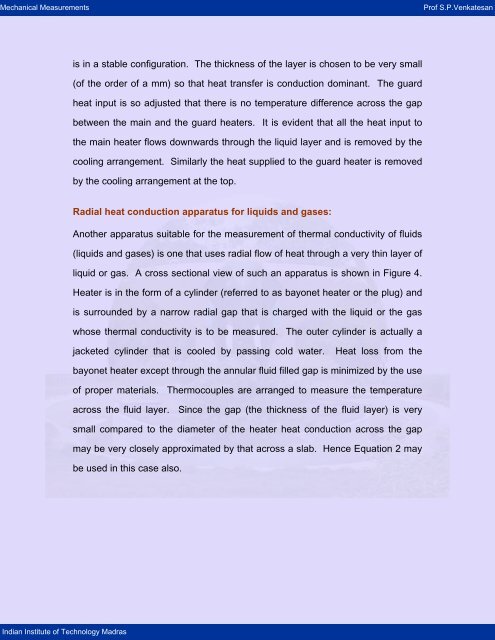1. Thermo-physical properties 2. Radiation properties - nptel - Indian ...
1. Thermo-physical properties 2. Radiation properties - nptel - Indian ...
1. Thermo-physical properties 2. Radiation properties - nptel - Indian ...
Create successful ePaper yourself
Turn your PDF publications into a flip-book with our unique Google optimized e-Paper software.
Mechanical Measurements Prof S.P.Venkatesan<br />
<strong>Indian</strong> Institute of Technology Madras<br />
is in a stable configuration. The thickness of the layer is chosen to be very small<br />
(of the order of a mm) so that heat transfer is conduction dominant. The guard<br />
heat input is so adjusted that there is no temperature difference across the gap<br />
between the main and the guard heaters. It is evident that all the heat input to<br />
the main heater flows downwards through the liquid layer and is removed by the<br />
cooling arrangement. Similarly the heat supplied to the guard heater is removed<br />
by the cooling arrangement at the top.<br />
Radial heat conduction apparatus for liquids and gases:<br />
Another apparatus suitable for the measurement of thermal conductivity of fluids<br />
(liquids and gases) is one that uses radial flow of heat through a very thin layer of<br />
liquid or gas. A cross sectional view of such an apparatus is shown in Figure 4.<br />
Heater is in the form of a cylinder (referred to as bayonet heater or the plug) and<br />
is surrounded by a narrow radial gap that is charged with the liquid or the gas<br />
whose thermal conductivity is to be measured. The outer cylinder is actually a<br />
jacketed cylinder that is cooled by passing cold water. Heat loss from the<br />
bayonet heater except through the annular fluid filled gap is minimized by the use<br />
of proper materials. <strong>Thermo</strong>couples are arranged to measure the temperature<br />
across the fluid layer. Since the gap (the thickness of the fluid layer) is very<br />
small compared to the diameter of the heater heat conduction across the gap<br />
may be very closely approximated by that across a slab. Hence Equation 2 may<br />
be used in this case also.
















